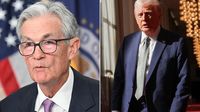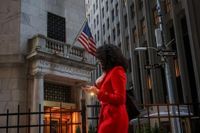As the first quarter of 2025 nears an end, fresh market analyses reveal troubling trends for the U.S. stock market, driven largely by President Donald Trump's aggressive economic policies. Investors are grappling with profound declines across major indices, signaling a potential shift in financial fortunes as the S&P 500 index fell by 7.6 percent since February 19, and prominent tech stocks suffered even steeper declines, averaging a drop of nearly 15.6 percent.
Market experts are voicing concerns about these setbacks, particularly as they coincide with the Federal Reserve's revised economic forecasts. Jerome Powell, the Fed chief, has indicated a dimming outlook, predicting 1.7 percent growth for the year, down from an earlier estimate of 2.1 percent. Inflation projections have ballooned to 2.7 percent for 2025 due, in part, to the fallout from tariffs imposed by the Trump administration. As Powell noted, "clearly . . . a good part of it is coming from tariffs," highlighting the economic turbulence triggered by trade tensions.
On March 16, Treasury Secretary Scott Bessent seemed unfazed by the stock market's instability, stating, "I can tell you that corrections are healthy, they are normal." The current economic situation has led many to connect the dots between Trump's trade policies and market volatility. Since Trump's inauguration, American markets have displayed a stark underperformance compared to their Asian counterparts, with the CSI 300 Index in China rising 5.2 percent during the same timeframe, driven by optimism in its tech sector.
American investors are feeling the strain, compounded by consumer confidence wavering amid fears of economic slowdown. Financial institutions report declines in retail sales and sentiments of a looming recession. According to Bank of America’s global fund manager survey conducted on March 18, allocations to U.S. stocks experienced the sharpest decline on record, as nearly 70 percent of respondents feel U.S. exceptionalism has hit its peak.
Compounding these fears is the perception that Trump's administration exhibits a concerning nonchalance toward declining market figures. Investor sentiment is increasingly worried that Trump's casual dismissal of falling stocks—coupled with the administration's trade war strategies—is contributing to a culture of unease among American businesses and reduced investor confidence.
In contrast, the mood seems buoyant in China, where stocks have outperformed those in the U.S., particularly due to the promise of the country's tech sector. The MSCI China Index has seen dramatic gains of nearly 28 percent, and the Hong Kong-based Hang Seng Index has climbed 26 percent. This stark difference illustrates the shifting landscape for global investors amid geopolitical changes and a rearrangement of economic strategies in both regions.
Reflecting on the optimistically perceived Chinese comeback, investor and portfolio manager Taosha Wang remarked, "Chinese equities may represent a structural hedge against waning U.S. exceptionalism, transcending cyclic rebounds, given today's massive geopolitical and technological shifts— from U.S. political volatility to AI democratization. But this is not a zero-sum game." Wang's insight captures the essence of a transforming global market where U.S. dominance no longer remains the absolute benchmark.
Investors are alert to warnings that the rejuvenation of the Chinese market could soon face challenges. Bank of America strategists cautioned that a "meaningful correction soon" is possible, invoking memories of the seismic shifts seen during China’s 2015 market crash. Such predictions amplify the need for U.S. stakeholders to reconsider their investment pathways amidst relentless competition.
Powell's Fed remains steadfast amidst uncertainty, as rates hold steady at 4.25 to 4.5 percent despite pressure from the White House for cuts. Powell hinted at careful monitoring of the administration’s shifting trade and regulatory policies. As he put it, “The economy seems to be healthy. We understand that sentiment is quite negative at this time.” This dichotomy—between official outlooks and market realities—poses a persistent dilemma for investors as they navigate these turbulent times.
The divergent trajectories of U.S. and Chinese stock markets amplify an urgent dialogue on the implications of Trump's policies. As American businesses, consumers, and investors adjust to an environment rife with volatility, eyebrows are raised about the sustainability of recovery and the lasting effects of policy decisions made amid uncertainty. The recent downturn underscores a growing hesitance about U.S. financial dominance and the need to confront global challenges posed by foreign competitors.
As the United States moves forward in a complex economic climate, the focus remains on the intertwined fortunes of domestic markets and the evolving geopolitics shaping global financial landscapes. With questions lingering regarding consumer spending and investor confidence, it is clear that navigating these currents will require not just resilience, but also an astute understanding of the changing tides of the international market.





